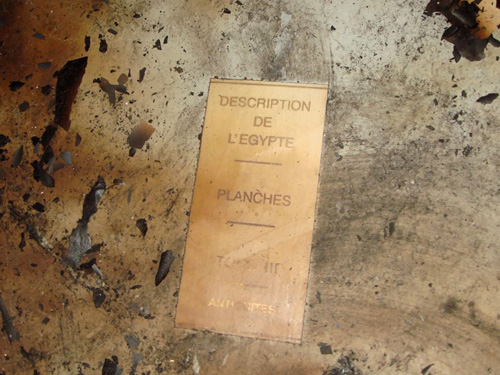
Fighting broke out once again inside the Egyptian Scientific Institute on Monday, two days after the building was set on fire amid ongoing clashes between pro-democracy protesters and security forces. The building, which is located on the corner of Qasr al-Aini Street and Sheikh Rihan Street in downtown Cairo, on the front line of the clashes, was set ablaze on Saturday morning.
Built by Napoleon Bonaparte in 1798 and orginally named the Institut d'Egypte, the institute was home to thousands of rare manuscripts, many of which were destroyed in the fire.
On Monday night, three soldiers appeared on the rooftop of the building, which was expected to collapse soon, according to the National Organization for Urban Harmony. The soldiers started throwing rocks at the protesters. After a few minutes of chaos, with protesters trying to escape the projectiles, a short truce seemed to have taken effect. The soldiers disappeared, only to re-appear carrying a pink plastic bucket full of rubble, which they then proceeded to hurl down on protesters in the streets below.
Amongst those who ran for cover was a group of volunteers from the sit-in on Sheikh Rihan Street, who had formed The Popular Committee for Rescuing the Egyptian Scientific Institute with the aim of protecting the building until Dar al-Kotob (The National Library) could send more trucks and conservators to pick up the books. Minutes after the soldiers resumed their attack, another group of youngsters entered the building and attempted to gain access to the roof in order to capture the soldiers, but failed.
During a televised news conference on Monday morning, SCAF member General Adel Emara described the torching of the institute as “a shame for every Egyptian.” He did not mention, however, that even before the fire started, soldiers had been using the roof of the building as a base from which to launch attacks on protesters, hurling rocks and other objects into the street. Nor did he mention the fact that efforts to salvage the collection — which includes original volumes of the "Description de l'Égypte” — were being coordinated by civilians, with little or no help being provided by soldiers.
Protesters initiate rescue
Since Saturday night, activists and protesters, and later conservators and volunteers with Dar al-Kotob, have been trying to salvage books and documents scattered around and within the building.
On Saturday night, protesters — wary of rocks, fireworks, Molotov cocktails and gunshots — made their way through the clashes. They swept Sheikh Rihan Street, moving thousands of scraps of paper and leather along the exterior of the American University in Cairo’s Ewart Hall, where they sifted through them under the gaze of armed soldiers. The soldiers, assisted by several plain-clothed individuals, had created a clearing between the protestors and their own barb-wired barricade, covering most of the area where the documents had been dumped.
“You’ve got five minutes to clear this mess up,” one soldier barked as he cut through the crowd, his face hidden behind a ski mask. Behind him were several lines of mask-less and mostly smirking soldiers, preventing anyone from going further down the street. They were not acknowledging the book-collecting activists, or the protesters tearing up the asphalt right in front of them, clawing for ammunition to be used in the next inevitable round of rock-slinging.
“This is a national tragedy,” lamented one old protester over the 200,000 books and manuscripts stored in the building. “I don’t work at the Institut d’Egypte,” he explained to Egypt Independent. “But I was the first one here trying to put out the flames. I did more to protect it than the people who actually work there.”
As the fighting continued, one woman sobbed on the street corner, pointing at a lonely, sodden page on the pavement. “Description de l’Egypte – Planches,” it read.
When the group ran out of cardboard boxes and plastic bags long before half the papers had been collected, a masked soldier warned that anyone who left to get more boxes would not be allowed back into the clearing. “I don’t even understand why so many of you need to be here,” he grunted.
Egypt Independent reporters saw mostly scattered pages, burnt and shredded. Many were impossible to pick up without destroying them completely. Pages unconsumed by flames had been destroyed by firehoses and late-night mist.
On Sunday, as the fighting continued, protesters continued to drop off books at the military checkpoint guarding the US Embassy. The lieutenant on site confirmed to Egypt Independent that it was protesters who brought in all the books.
“It’s civilians who are managing the whole rescue operation,” said a young member of the popular committee. “This has been the case even before the military built the wall on Sheikh Rihan.” The popular committees are coordinating with cultural activists and conservators volunteering with Dar al-Kotob, he explains.
Sifting through the remains
Back at Dar al-Kotob, dozens of conservators are going through the rescued books. Several institutions are coming in to help, including the Cairo University Library, the Bibliotheca Alexandrina, and the Rare Books Library of the American University in Cairo.
“But it’s not just conservators who are helping out. So many volunteers are coming in,” says Elena Chardakliyska, an assistant director of the Thesaurus Islamicus Foundation and Dar al-Kotob Manuscript Project. Volunteers unload the trucks and lay the books on the floor, sorting them according to their condition. Some can be immediately worked on; others need to be wrapped in newspaper and airtight plastic bags to absorb the moisture. “We are all here receiving emergency training on the spot,” she adds, “as most of the specialists and volunteers have not worked on saving a burning library before.”
Zein Abdel Hady, director of Dar al-Kotob, said some of the books received are in good condition, tightly kept in their leather binding. But many remain under the rubble, especially since the institute’s second floor collapsed, making it harder for volunteers to go in.
“Even when we manage to get in, we have to deal with the books very delicately. Once pulled from under the rubble, they burst into flames,” explains Yasmine al-Dourghamy, the editor of the quarterly cultural magazine al-Rawi, who has been working with conservators on bringing books out of the building.
Another concern is that some books, manuscripts and maps that left the building have not yet made it to Dar al-Kotob. Some volunteers dropped them off at nearby military checkpoints. Others refused to do that, due to rising tensions with the military.
As far as the retrieved books are concerned, the restoration process is expected to take 10 years, announced Hesham Farag, Head of the Central Security Unit at the Culture Ministry on Monday.
“It will take a long time,” confirms Dourghamy, especially since most books were burned at the corners where page numbers were printed. “The restoration process will be like trying to solve a jigsaw puzzle.”
The process could be helped along by reference to copies of books held at Dar al-Kotob, the Cairo University Library and University of Assiut, as Culture Minister Shaker Abdel Hamid confirms. But most crucial will be comparing them to the digitized copies available at the Information and Decision Support Center at the cabinet building on Qasr al-Aini Street, says Abdel Hamid. Whether it will be possible to rescue the books still inside before the building collapses remains difficult to predict.
Photos courtesy of May Shalaby




